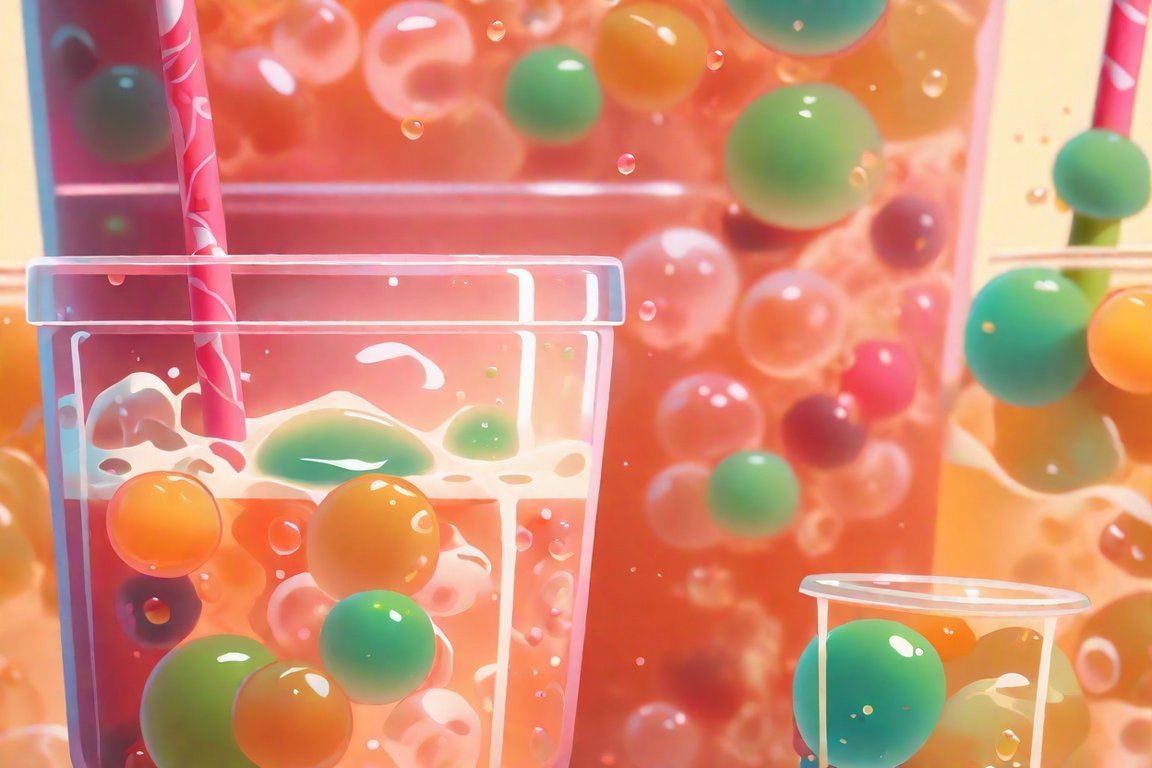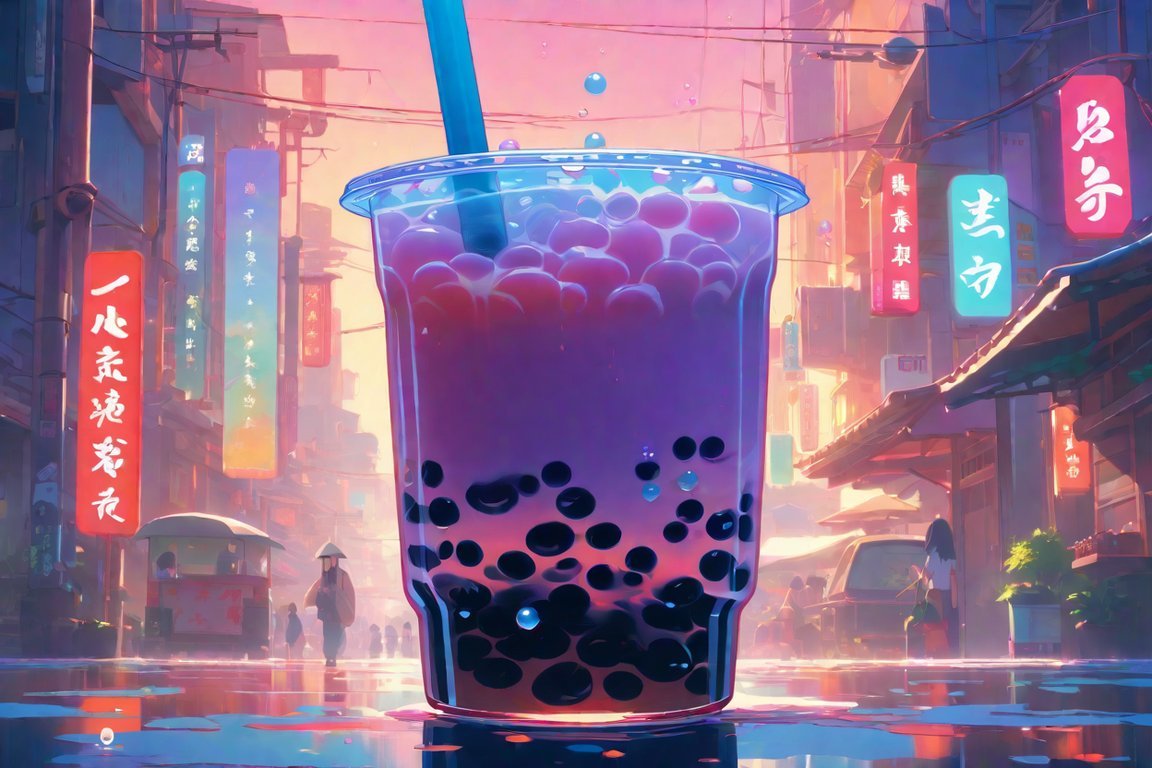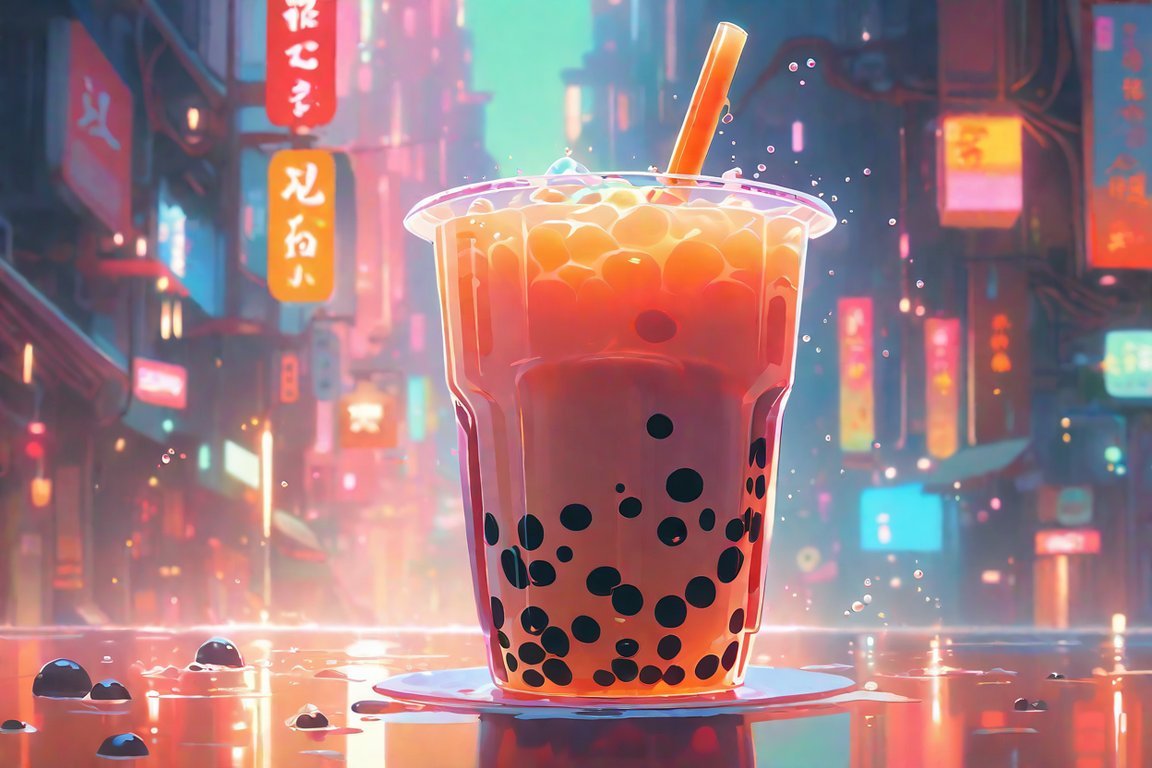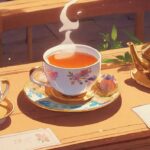Boba, also known as bubble tea, has taken the world by storm with its unique combination of tea, milk, and chewy tapioca pearls. In this article, we will delve into the fascinating facts about boba, exploring the global obsession with this beloved beverage. From its intriguing history to its quirky characteristics, join us on a journey to uncover the secrets behind the growing popularity of boba.

Key Takeaways:
- Boba is a popular drink made with tea, milk or fruit, and chewy tapioca balls that are sucked through a wide straw.
- Boba offers a unique taste and edible experience, with a wide variety of flavors and toppings.
- The drink has aesthetic appeal for social media sharing and is highly customizable, allowing customers to control the sugar level, type of tea, and milk used.
- Boba originated in Taiwan in the 1980s and is also known as bubble tea, pearl tea, or tapioca tea.
- The tapioca balls in boba are made from cassava root and give the drink a unique texture and chewiness.
- Cassava root has been used as a source of carbohydrates since the 1400s and the tapioca balls are made by boiling the root’s starch in hot water.
- Boba tea has gained global popularity due to its taste, customizable nature, and aesthetic appeal for social media sharing.
Facts About Boba
Boba, also known as bubble tea, is a popular and unique beverage that has taken the world by storm. With its combination of tea, milk or fruit, and chewy tapioca balls, it offers a truly delightful and edible experience. But what are some fascinating facts about boba that you may not know? Let’s explore the world of this beloved drink and uncover some intriguing details.
The Origins of Boba
Boba tea originated in Taiwan and gained popularity in the 1980s. It was first created by a creative employee named Lin Hsui Hui at the Chun Shui Tang teahouse. Since then, it has become a global phenomenon, capturing the hearts and taste buds of people around the world.
Boba vs. Bubble
You may be wondering why it’s called bubble tea when the bubbles actually refer to the foam on top of the drink. The tapioca balls themselves are not the “bubbles.” This unique name adds to the charm and curiosity surrounding boba tea.
Cassava Root: The Source of Boba
The chewy tapioca balls that make boba tea so distinctive are made from cassava root. This long tuberous plant is native to Brazil and has been a source of carbohydrates since the 1400s. The starch extracted from the cassava root gives boba its unique texture and chewiness.
Customizable and Inclusive
One of the reasons for boba’s immense popularity is its customizability. You have the freedom to control the sugar level, type of tea, and milk used in your drink. This versatility extends to dietary restrictions as well, making boba a favorite among the vegan and gluten-free crowd.
Aesthetic Appeal for Social Media
Boba tea not only tantalizes the taste buds but also captures attention through its aesthetic appeal. The colorful and Instagram-worthy nature of boba drinks has made them the perfect subject for social media sharing. So next time you enjoy a boba tea, don’t forget to snap a picture before taking your first sip!
More Facts to Discover
If you’re craving more facts about bubble tea, there are plenty of resources available. Websites like facts.net offer a compilation of 50 bubble tea facts and statistics. You can also check out spoonuniversity.com for 15 things you should know about bubble tea.
In conclusion, boba tea is much more than just a tasty beverage. It represents a cultural trend and an edible experience that has captivated people worldwide. With its interesting history, unique ingredients, and customizable nature, boba tea offers a delightful journey for both your taste buds and your curiosity. So why not join the global obsession and indulge in the world of boba?
Check out these fascinating facts on architecture. Click here to learn more.
Discover captivating information about the coastal plains by clicking here.
Uncover interesting facts about macarons by clicking here.
Explore the intriguing history of the Karnak Temple by clicking here.
Satisfy your curiosity with some mouthwatering facts about churros. Click here to indulge.
Dive into the world of slime and explore its surprising facts by clicking here.
Interested in learning more about coastal plains? Click here to discover some fascinating information.
Uncover the mysteries of the Maya civilization by clicking here.
Discover intriguing facts about Chad by clicking here.
Satisfy your sweet tooth and explore dessert facts by clicking here.
Uncovering the Unique Ingredients and Preparation Process of Boba
Boba tea has taken the world by storm, captivating taste buds and social media feeds alike. But have you ever wondered about the secret behind this delectable drink? In this article, we’ll uncover the unique ingredients and preparation process of boba, providing an inside look into what makes it so special.
Tapioca Pearls: The Chewy Delight
At the heart of every boba tea lies the iconic tapioca pearls. Made from cassava starch or seaweed extract, these little chewy orbs are gluten-free and vegan-friendly. Tapioca pearls have been a beloved ingredient in Taiwanese cuisine for ages, and they add a wonderful texture to boba tea.
The Perfect Blend: Tea and Milk
The blend of tea and milk is what sets boba tea apart from other beverages. It was in 1949 that Chang Fan Shu, a former bartender who opened a tea shop, perfected this combination. Today, boba tea enthusiasts can choose from a variety of tea options, including black, green, oolong, and even fruit-infused teas. The addition of milk creates a creamy and luscious base that perfectly complements the tapioca pearls.
Crafting Your Own Boba Tea
Making boba tea at home is easier than you might think. Simply steep your favorite tea in boiling water for around five minutes, strain it, and then add the tapioca pearls. You can customize the sugar level, type of tea, and milk according to your preference. With boba tea kits and the necessary ingredients readily available, you can enjoy this delightful drink in the comfort of your own kitchen.
The Rise of Boba Tea
Boba tea has become a global phenomenon, with over 3,400 shops in the United States alone. Its popularity can be attributed to its visually appealing aesthetics and the endless possibilities for customization. Furthermore, boba tea has gained a dedicated following among vegans and those seeking gluten-free options, thanks to its tapioca-based pearls and availability of plant-based milk alternatives.
Further Exploration
For those eager to dive deeper into the world of boba, various resources offer tantalizing recipes and intriguing facts. Websites like Tasty.co, Healthy Nibbles And Bits, and Simply Recipes provide popular boba tea recipes that are worth a try. Additionally, Scientific American offers an article on making boba for bubble tea using tapioca flour, water, and brown sugar, while Today.com explores the history and popularity of boba tea in Taiwan. If you’re seeking comprehensive information, Wikipedia sheds light on the ingredients and offers insights into bubble tea’s cultural significance.
Key Takeaways:
- Boba tea consists of tea, milk, water, sugar, and tapioca pearls.
- Tapioca pearls are made from cassava starch or seaweed extract and are gluten-free and vegan.
- The blend of tea and milk in boba tea was perfected in 1949 by Chang Fan Shu, a former bartender who opened a tea shop.
- Boba tea is easy to make at home by steeping tea in boiling water and adding tapioca pearls.
- Boba tea has gained popularity worldwide, with numerous shops offering this delightful beverage.
- Various websites and resources provide recipes and information on making boba tea.
Sources:
– What is Boba Tea – EatingWell
– Make Boba for Bubble Tea – Scientific American
Exploring the Cultural Significance and Global Spread of Boba
Origins of Boba Tea
– Boba tea, also known as bubble tea, originated in Tainan, southern Taiwan in 1986 [^1^].
– It was initially called foam tea and consisted of iced tea with fine air bubbles.
– Over time, boba tea evolved into the beloved beverage we know today.
Evolution of Boba Tea
– As boba tea became more popular in Taiwan, different variations emerged.
– Fruit boba, made with fruit powders and syrups, became a hit [^2^].
– Toppings like grass jelly, almond jelly, egg pudding, and red beans were added, enhancing the diverse flavors of boba tea [^3^].
Global Spread of Boba Tea
– In the late 1990s and early 2000s, Taiwanese expatriates and entrepreneurs introduced boba tea shops worldwide [^1^].
– Today, boba tea is enjoyed across the globe, with a wide range of flavors and combinations to cater to everyone’s taste preferences.
– Its unique appeal lies in its ability to bring together different cultures, flavors, and textures.
Cultural Significance of Boba Tea
– Boba tea has not only become a beloved drink but also a symbol of identity and culture.
– It has become an integral part of immigrant communities in California and college towns across the United States [^4^].
– Boba tea shops in places like the San Gabriel Valley and Los Angeles have become gathering grounds and a part of Asian-American youth culture [^5^].
– The Chinese American Museum in L.A. even features an exhibit exploring the roots and journey of boba tea [^8^].
Key Takeaways:
- Boba tea originated in Tainan, southern Taiwan in 1986.
- It has evolved from foam tea to the diverse beverage we know today.
- The global spread of boba tea began with Taiwanese expatriates and entrepreneurs.
- Boba tea has become a symbol of identity and culture in immigrant communities and college towns.
- It has become embedded in Asian-American youth culture in places like the San Gabriel Valley and Los Angeles.
Sources:
1. YAAAS TEA – The Global Journey of Boba Tea: History, Ingredients…
2. Boba History: Origins of the Beloved Bubble Tea – FOODICLES
The Health Benefits and Potential Drawbacks of Consuming Boba
Boba tea, also known as bubble tea, has gained immense popularity in recent years as a trendy and refreshing beverage. However, when it comes to its health benefits, boba tea falls short and may even have negative effects on long-term health. In this article, we will explore the potential drawbacks and limited benefits of consuming boba tea.
The Drawbacks of Boba Tea
One of the main concerns with boba tea is its high sugar content. Most boba teas are loaded with sugar, which can contribute to long-term health conditions like diabetes and obesity. Excessive sugar consumption in boba tea can lead to weight gain and increase the risk of developing chronic diseases. It is essential to be cautious and limit the consumption of boba tea with high sugar content.
Another drawback of boba tea is the tapioca pearls used in the drink. While tapioca pearls may offer some potential benefits, individuals who are intolerant to high amounts of starch should avoid boba tea. Additionally, tapioca pearls can be a choking hazard, especially for young children. It is important to be aware of these risks and consume boba tea responsibly.
The Limited Health Benefits of Boba Tea
Although boba tea contains negligible health benefits, it is essential to consider its overall nutritional value. While most boba teas lack substantial health benefits, the tapioca pearls in boba milk tea may help add more calcium to your saliva and decrease the levels of C-reactive proteins.
However, it is crucial to note that these potential benefits are minimal and not enough to outweigh the harmful effects of high sugar content and other drawbacks associated with boba tea.
Key Takeaways:
- Boba tea contains high sugar content, which can contribute to long-term health conditions like diabetes and obesity.
- Tapioca pearls in boba tea may not be suitable for individuals who are intolerant to high amounts of starch.
- Tapioca pearls can be a choking hazard, particularly for young children.
- Boba tea does not provide significant health benefits, and the potential benefits of tapioca pearls are minimal.
Sources:
– Boba Tea: Are There Health Benefits? – WebMD
– Boba Nutrition Facts: Calories, Carbs, and Health Benefits – Verywell Fit

FAQ
Q1: What is boba tea?
A1: Boba tea is a popular drink made with tea, milk or fruit, sugar, and tapioca pearls. It is known for its unique taste, chewy texture, and wide variety of flavors and toppings.
Q2: Where did boba tea originate?
A2: Boba tea originated in Taiwan and became popular in the 1980s. It is also known as bubble tea, pearl tea, or tapioca tea.
Q3: What are tapioca pearls?
A3: Tapioca pearls are small, chewy balls made from cassava root starch. They are boiled until they reach a gummy bear-like consistency and are then added to boba tea.
Q4: Can boba tea be customized?
A4: Yes, boba tea is highly customizable. Customers can control the sugar level, type of tea, and milk used in their drink. This versatility has contributed to its popularity.
Q5: Is boba tea vegan and gluten-free?
A5: Yes, boba tea can be made vegan and gluten-free. Tapioca pearls are made from cassava root starch, which is naturally gluten-free, and boba tea can be made without milk or with alternative milk options for those following a vegan lifestyle.
- How Black Are You Quiz: Understand Your Score & Black Culture - April 15, 2025
- How Political Parties Choose Their Leaders: A Comprehensive Guide - April 15, 2025
- Discover Famous French Singers: A Complete Guide - April 15, 2025
















